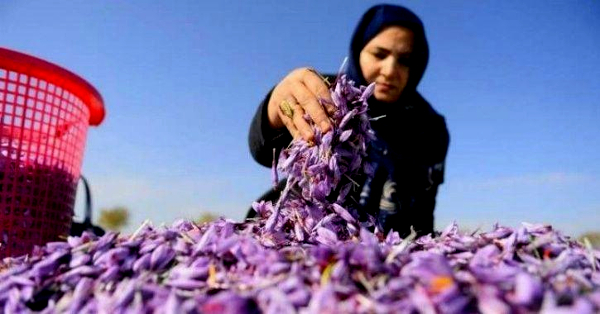Starting before dawn has even broken, Afghanistan’s army of saffron pickers shift their way across sun-baked fields to pluck the brightly coloured crocuses that are providing the country’s farmers with a new means of income.
The delicate pistil of the flower has for centuries been used in cooking around the world and because of its relatively high price has been dubbed “red gold” by those who rely on its cultivation.
Joma Khan is one of the 156,000 seasonal workers who help harvest the spice, earning about $1 an hour.
“We start our field work before sunrise and each of us can collect about four to five kilograms of saffron flower,” the 16-year-old said.
The harvest is then sent to factories where gloved workers remove the red pistil, made up of the three stigma that when dried constitute the spice.
Authorities struggling to wean farmers off the highly profitable opium poppy trade are hoping to use the spice as an attractive alternative.
And the results are looking positive, thanks to billions of dollars of international aid.
The saffron harvest hit 13 tonnes this year, compared with a tonne in 2013, according to agriculture ministry spokesman Akbar Rostami.
Cultivation requires little water, meaning it has not been heavily impacted by the historic drought currently threatening nearly three million Afghans with famine.
It has even intensified in some drought-hit areas, especially in the northwestern province of Herat on the border with Iran and Turkmenistan.
Official figures show saffron cultivation has increased to 6,200 hectares of land in 2018, up 21 percent on last year.
However, there is still a way to go, with 263,000 hectares currently given over to poppy production. And while the saffron sector generated $35 million in 2017, opium made an incredible $1.4 billion.
Iran remains the world’s largest saffron producer, capturing nearly 90 percent of the global market with 400 tonnes annually. Meanwhile, nearly 90 percent of the opium harvested on the planet still comes from Afghanistan.
Prices for the spice have also fallen, from more than $900 at the start of the year to $660 now, due in part to mafias who illegally import Iranian saffron and flood the market, Rostami said.
Nevertheless, the increased cultivation of is being seen as a positive sign.
The spice is being exported to 17 countries through new air corridors, mainly to China, India, and the Gulf countries, and to a lesser extent to the European Union and North America, says the agriculture ministry
“Afghanistan’s saffron, based on its organic nature, it is better than other saffron in the world,” claimed Abdul Shukoor Ahrari, director of Tila-e-Surkh Afghan (“Afghan Red Gold”), one of the country’s main processing sites.
Source:RTL
Image Courtesy:AFP
You may also like
-
Beware! Chinese Hackers are Using VLC Media Player to Spy on You
-
Israel Participates in US Mideast Naval Exercise wih Saudi Arabia and Oman – IMX 22
-
Pakistani Establishment Controlling ‘Family Business’ of Selling Kashmir Narrative, Uses Issue as Survival Strategy: Report
-
After Suspending Twitter ‘Indefinitely’, Nigerian Govt Joins Made-In-India Microblogging Platform ‘Koo’
-
Pam Gosal, First Indian-Origin Woman to be Scottish Lawmaker
